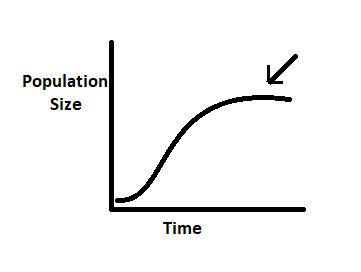
In the given graph arrow indicates specifically:

A. r
B. K-N
C. K
D. Density independent effect

Answer
352.5k+ views
Hint: The above graph represents population size v/s time curve. The process of a population's rate of growth slowing as the number of people in the population grows is known as logistic population growth. Here, K is the carrying capacity which is the average population size of the species in a particular habitat.
Complete step-by-step answer:
It is a population growth curve with a logistic or geometric growth pattern.
We can see the graph between population density (N) on the Y-axis and time (t) on the X-axis, which results in a given curve.
The given growth curve represents the relationship between N and t (population density and time) as an exponential or geometric growth of population growth.
As a result, the graph in the diagram represents exponential or geometric increases in the population.
Logistic growth can be thought of as a mathematical equation. The rate of population growth (N) is measured in terms of the total number of people in a population over time (t). The rate of population growth is denoted by $\left ( \dfrac{dN}{dt} \right )$. The d simply represents variation. K represents carrying capacity, and r represents the maximum per capita rate of growth for a population. The word "per capita" refers to an individual, while the per capita growth rate considers both births and deaths in a population. Based on the logistic growth equation, K and r in a population do not change over time.
$\dfrac{dN}{dt}=rN\left ( \dfrac{K-N}{K} \right )$
Hence, the correct option is C
Note: We need to note that logistic growth gives S shape curve whereas exponential growth gives J shaped curve. For population growth to be exponential, the rate of growth must be constant over time.
Complete step-by-step answer:
It is a population growth curve with a logistic or geometric growth pattern.
We can see the graph between population density (N) on the Y-axis and time (t) on the X-axis, which results in a given curve.
The given growth curve represents the relationship between N and t (population density and time) as an exponential or geometric growth of population growth.
As a result, the graph in the diagram represents exponential or geometric increases in the population.
Logistic growth can be thought of as a mathematical equation. The rate of population growth (N) is measured in terms of the total number of people in a population over time (t). The rate of population growth is denoted by $\left ( \dfrac{dN}{dt} \right )$. The d simply represents variation. K represents carrying capacity, and r represents the maximum per capita rate of growth for a population. The word "per capita" refers to an individual, while the per capita growth rate considers both births and deaths in a population. Based on the logistic growth equation, K and r in a population do not change over time.
$\dfrac{dN}{dt}=rN\left ( \dfrac{K-N}{K} \right )$
Hence, the correct option is C
Note: We need to note that logistic growth gives S shape curve whereas exponential growth gives J shaped curve. For population growth to be exponential, the rate of growth must be constant over time.
Recently Updated Pages
Master Class 12 Business Studies: Engaging Questions & Answers for Success

Master Class 12 Economics: Engaging Questions & Answers for Success

Master Class 12 English: Engaging Questions & Answers for Success

Master Class 12 Maths: Engaging Questions & Answers for Success

Master Class 12 Social Science: Engaging Questions & Answers for Success

Master Class 12 Chemistry: Engaging Questions & Answers for Success

Trending doubts
What is BLO What is the full form of BLO class 8 social science CBSE

What is meant by exothermic and endothermic reactions class 11 chemistry CBSE

Which places in India experience sunrise first and class 9 social science CBSE

Which animal has three hearts class 11 biology CBSE

Who was the first woman to receive Bharat Ratna?

What are the major means of transport Explain each class 12 social science CBSE




